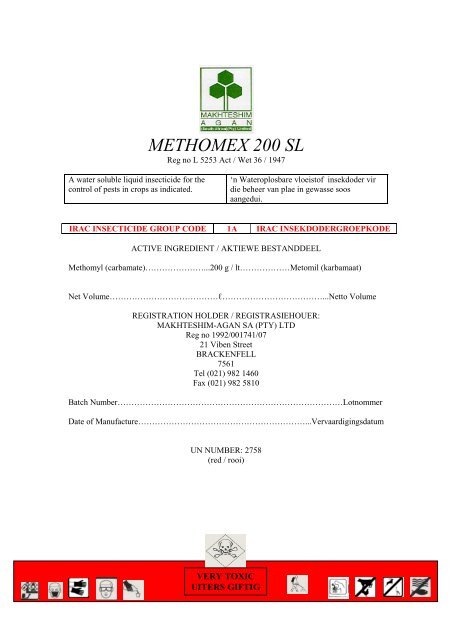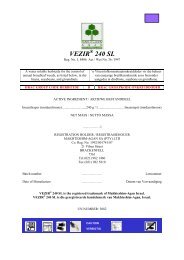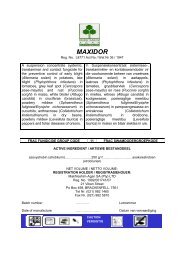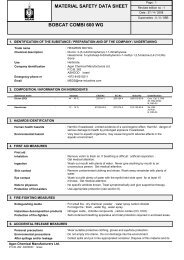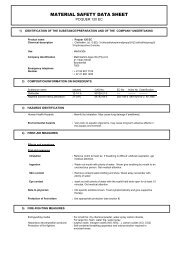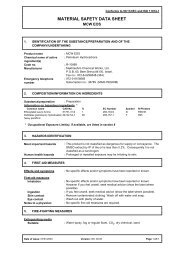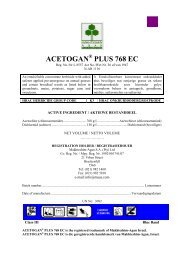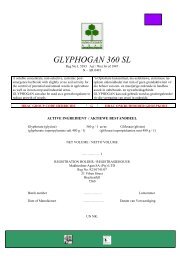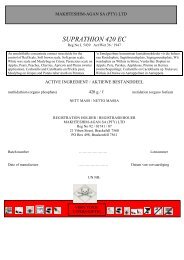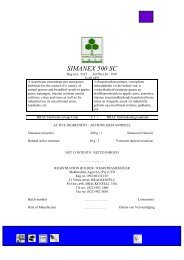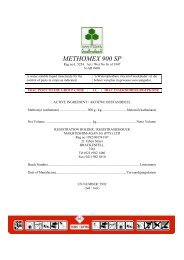METHOMEX 200 SL - Makhteshim-Agan SA (Pty) Ltd
METHOMEX 200 SL - Makhteshim-Agan SA (Pty) Ltd
METHOMEX 200 SL - Makhteshim-Agan SA (Pty) Ltd
You also want an ePaper? Increase the reach of your titles
YUMPU automatically turns print PDFs into web optimized ePapers that Google loves.
A water soluble liquid insecticide for the<br />
control of pests in crops as indicated.<br />
<strong>METHOMEX</strong> <strong>200</strong> <strong>SL</strong><br />
Reg no L 5253 Act / Wet 36 / 1947<br />
‘n Wateroplosbare vloeistof insekdoder vir<br />
die beheer van plae in gewasse soos<br />
aangedui.<br />
IRAC INSECTICIDE GROUP CODE 1A IRAC INSEKDODERGROEPKODE<br />
ACTIVE INGREDIENT / AKTIEWE BESTANDDEEL<br />
Methomyl (carbamate)…………………...<strong>200</strong> g / lt………………Metomil (karbamaat)<br />
Net Volume…………………………………ℓ………………………………...Netto Volume<br />
REGISTRATION HOLDER / REGISTRASIEHOUER:<br />
MAKHTESHIM-AGAN <strong>SA</strong> (PTY) LTD<br />
Reg no 1992/001741/07<br />
21 Viben Street<br />
BRACKENFELL<br />
7561<br />
Tel (021) 982 1460<br />
Fax (021) 982 5810<br />
Batch Number………………………………………………………………………Lotnommer<br />
Date of Manufacture……………………………………………………...Vervaardigingsdatum<br />
UN NUMBER: 2758<br />
(red / rooi)<br />
VERY TOXIC<br />
UITERS GIFTIG
WARNINGS<br />
WITHOLDING PERIOD: Number of days which should be allowed between the last application and<br />
harvest or grazing (feeding) of the crop:<br />
Citrus – 90 ml / 100 ℓ dosage ........................................................................................................ 2 days<br />
Citrus – higher than 90 ml / 100 ℓ dosage ................................................................................... 28 days<br />
Cruciferae....................................................................................................................................... 4 days<br />
Grain sorghum, maize, pastures, wheat, lupins, lucerne, tobacco (flue-cured) ............................. 7 days<br />
Green beans.................................................................................................................................. 14 days<br />
Hops ............................................................................................................................................... 7 days<br />
Peaches......................................................................................................................................... 16 days<br />
Potatoes.......................................................................................................................................... 3 days<br />
Tobacco (air-cured)...................................................................................................................... 14 days<br />
Tomatoes........................................................................................................................................ 2 days<br />
<strong>METHOMEX</strong> <strong>200</strong> <strong>SL</strong> MAY CAUSE YELLOWING OF THE LEAF TIPS WHEN USED ON<br />
CERTAIN CARNATION VARIETIES. DO NOT USE <strong>METHOMEX</strong> <strong>200</strong> <strong>SL</strong> IN COMBINATION<br />
WITH WETTING AGENTS ON TOBACCO SEEDBEDS OR ON CITRUS.<br />
• Handle with extreme care.<br />
• Poisonous by contact, swallowing or inhalation a small quantity may be fatal if swallowed or<br />
inhaled.<br />
• Toxic to fish, bees and wildlife.<br />
• Store under lock and key, away from foodstuffs.<br />
• Keep container well closed. Keep out of reach of children, animals and uninformed persons.<br />
• In case of poisoning, call a doctor immediately and make this label available to him.<br />
Aerial application: Notify all inhabitants in the immediate vicinity of the area to be sprayed and issue<br />
the necessary warnings. Do not apply over water or adjacent areas that are not under treatment, or allow<br />
the spray mist to drift over these areas.<br />
Although this remedy has been extensively tested under a large variety of conditions, the<br />
registration holder does not guarantee that it will be effective under all conditions. The activity and<br />
effect thereof may be affected by factors such as abnormal soil, climatic and storage conditions,<br />
quality of dilution water, compatibility with other substances not indicated on the label and the<br />
occurrence of resistance of the pests against the remedy as well as by the method, time and<br />
accuracy of application. The registration holder furthermore does not accept responsibility for<br />
damage to crops, vegetation, the environment or harm to man or animal or for lack of performance<br />
of the remedy concerned due to failure by the user to follow the label instructions, or to the<br />
occurrence of conditions which could not have been foreseen in terms of the registration. Consult<br />
the supplier in the event of any uncertainty.<br />
PRECAUTIONS<br />
• Avoid inhalation of spray mist and fumes and contact with eyes, skin or clothing.<br />
• Wear protective clothing (overall, rubber boots, gloves and respirator).<br />
• Wash contaminated clothing daily.<br />
• In case of skin contact wash thoroughly with soap and water. Do not eat, drink or smoke while<br />
applying or preparing the spray mix, or before washing face and hands.
• Prevent drift of spray onto other crops, grazing, rivers and any area not under treatment.<br />
• Prevent contamination of food, feeds, drinking water and eating utensils.<br />
• Clean applicator before using for other materials and dispose of wash water where it will not<br />
contaminate crops, grazing, rivers or dams.<br />
• Rinse empty container three times with a volume of water that is equal to 10 % of the container.<br />
Add the rinsings to the spray tank<br />
• Destroy empty container in the prescribed manner and never use for any other purpose.<br />
SYMPTOMS OF HUMAN POISONING<br />
Headache, fatigue, faintness, giddiness, excessive sweating, nausea, abdominal pains, vomiting, blurred<br />
vision, muscle twitching, small pupils, respiratory distress and coma.<br />
FIRST AID TREATMENT<br />
• Remove patient from source of poisoning to a cool, well-ventilated area and keep him quiet and<br />
reassured.<br />
• Remove contaminated clothing and rinse contaminated body area thoroughly with plenty of soap<br />
and cold water. Do not rub skin.<br />
• Flush contamination out of eyes with clean water for at least 15 minutes.<br />
• If swallowed, induce vomiting by tickling the back part of the throat. Repeat until vomit fluid is<br />
clear and free from smell of poison. Take the patient immediately to the nearest physician.<br />
Administer artificial respiration or closed chest massage if necessary. Do not apply direct mouth-tomouth<br />
respiration. Never give anything by mouth to an unconscious person.<br />
NOTE TO PHYSICIAN<br />
Administer Atropine sulphate intravenously (1-4 mg) every 5 to 15 minutes until signs of atropinization<br />
(dry flushed skin and tachycardia). Pralidoxyme (2-PAM, Protopam) and other oximes are contraindicted.<br />
RESISTANCE WARNING<br />
For resistance management <strong>METHOMEX</strong> <strong>200</strong> <strong>SL</strong> is a group 1A insecticide. Any insect population<br />
may contain individuals naturally resistant to <strong>METHOMEX</strong> <strong>200</strong> <strong>SL</strong> and other group 1A code<br />
insecticides. The resistant individuals can eventually dominate the insect population if these insecticides<br />
are used repeatedly. The resistant insects may not be controlled by <strong>METHOMEX</strong> <strong>200</strong> <strong>SL</strong> or any other<br />
group 1A insecticide. To delay insecticide resistance:<br />
1. Avoid exclusive repeated use of insecticides from the same insecticide group code. Alternate or<br />
tank mix with products from different insecticide codes.<br />
2. For tank mixing or alternation with products in other insecticide group codes, refer to applicable<br />
product labels.<br />
3. Integrate control methods (chemical, cultural and biological) into disease control programs.<br />
For specific information on resistance management contact the registration holder of this product.<br />
DIRECTIONS FOR USE: USE ONLY AS INDICATED<br />
MIXING INSTRUCTIONS
Add the required amount to a half-full spray tank and mix thoroughly and fill up slowly while agitating<br />
(mechanical or hydraulic). Commence agitating of mixture a few minutes before starting to spray.<br />
Agitation is necessary to ensure thorough mixing of insecticide.<br />
Aerial application:<br />
Aerial application of <strong>METHOMEX</strong> <strong>200</strong> <strong>SL</strong> may only be done by a registered Aerial Application<br />
Operator using a correctly calibrated, registered aircraft according to the instructions of <strong>SA</strong>NS Code<br />
10118 (Aerial Application of Agricultural Pesticides). Ensure that the spray mixture is distributed evenly<br />
over the target area and that the loss of spray material during application is restricted to a minimum. It is<br />
therefore essential that the following criteria be met:<br />
• Volume: A spray mixture volume of 30 litres per hectare is recommended. As this product has not<br />
been evaluated at a reduced rate, the registration holder cannot guarantee efficacy, or be held<br />
responsible for any adverse effects if this product is applied aerially at a lower volume than<br />
recommended above.<br />
• Droplet coverage: 30 to 40 droplets per cm² must be recovered at the target area.<br />
• Droplet size: A droplet spectrum with a VMD of 250 to 280 microns is recommended. Limit the<br />
production of fine droplets less than 150 microns (high drift and evaporation potential) to a minimum.<br />
• Flying height: Maintain the height of the spray boom at 3 to 4 metres above the target. Do not spray<br />
when aircraft dives, is in a climb or when banking<br />
• Use suitable atomising equipment that will produce the desired droplet size and coverage, but which<br />
will ensure the minimum loss of product. The spraying system must produce a droplet spectrum with<br />
the lowest possible Relative Span.<br />
• Position all the atomisers within the inner 60 to 75 % of the wingspan to prevent droplets from<br />
entering the wingtip vortices.<br />
• The difference in temperature between the wet and dry bulb thermometers, of a whirling hygrometer,<br />
should not exceed 8°C.<br />
• Stop spraying if the wind speed exceeds 15 km/h.<br />
• Stop spraying under turbulent, unstable and dry conditions during the heat of the day.<br />
• Spraying under temperature inversion conditions (spraying in or above the inversion layer) and/or<br />
high humidity conditions (relative humidity 80 % and above) may lead to the following:<br />
a) reduced efficacy due to suspension and evaporation of small droplets in the air (inadequate<br />
coverage).<br />
b) damage to other sensitive crops and/or non-target areas through drifting of the suspended spray<br />
cloud away from the target field.<br />
• Ensure that the Aerial Spray Operator knows exactly which fields to spray.<br />
• Obtain an assurance from the Aerial Spray Operator that the above requirements will be met and that<br />
relevant data will be compiled in a logbook and kept for future reference.<br />
APPLICATION RATES:<br />
CROP AND DISEASE DO<strong>SA</strong>GE REMARKS<br />
CARNATIONS<br />
Carnation worm<br />
CITRUS<br />
Aphids and American<br />
bollworm<br />
Mealy bug<br />
450 ml / 100 ℓ water Ensure good coverage of the whole plant. Repeat<br />
weekly.<br />
90 ml / 100 ℓ water<br />
90 ml / 100 ℓ water<br />
Apply as a full cover spray when aphids and / or<br />
worms appear. Repeat when necessary.<br />
Apply as a full cover spray with a high pressure<br />
sprayer as soon as young nymphs appear on the
CROP AND DISEASE DO<strong>SA</strong>GE REMARKS<br />
Orange dog caterpillar<br />
Red scale<br />
Soft green scale<br />
Waxy scale<br />
CRUCIFERAE<br />
Larvae of the Diamond<br />
back moth, Greater<br />
cabbage moth and Aphids<br />
American bollworm<br />
GRAIN SORGHUM,<br />
WHEAT, LUPINS AND<br />
LUCERNE<br />
American bollworm<br />
GRAZING AND<br />
OTHER CROPS<br />
Army worm<br />
115 ml / 100 ℓ water<br />
450 ml plus 3 ℓ light<br />
narrow range mineral oil<br />
per 100 ℓ water.<br />
90 ml plus 500 mℓ<br />
narrow range mineral oil /<br />
100 ℓ water.<br />
115 ml / 100 ℓ water<br />
225 ml / 100 ℓ water<br />
1125 ml / ha<br />
900 ml / ha<br />
900 ml / ha<br />
225 ml / 100 ℓ water<br />
fruit. Repeat if necessary.<br />
Apply as a light cover spray as soon as larvae are<br />
noticed.<br />
Corrective treatment: Apply when 25 to 40 % of<br />
the fruit is infested with one or more live nymphs<br />
or adult scale.<br />
WARNING: Fruit bearing trees: Only one<br />
application must be made between December and<br />
March for late cultivars. Early cultivars may only<br />
be sprayed in December or January and not later<br />
than January. Application must be made with<br />
high pressure air compressor handguns. Do not<br />
apply with conventional citrus spray rigs.<br />
Apply as a full cover spray with a high pressure<br />
pump when the first visible signs of infestation are<br />
seen. Do not use less than 500 mℓ oil / 100 ℓ<br />
water.<br />
Apply as a full cover spray with a high pressure<br />
pump as young nymphs of a new generation move<br />
from the leaves to the twigs. This treatment will<br />
not be successful against adult waxy scale.<br />
Apply when worms first appear on the leaves.<br />
Use up to 500 ℓ spray mixture / ha. During hot<br />
weather and peak infestations, shorten the spray<br />
intervals to between 3 and 5 days. Ensure<br />
thorough wetting of the plants.<br />
Ground application: Apply in sufficient water<br />
to ensure good coverage.<br />
Aerial application: Apply in 30 ℓ water as soon<br />
as worms appear. Repeat if necessary.<br />
Aerial application: Apply in 30 ℓ water when<br />
pests are noticed. Repeat as necessary.<br />
Ground application: Low volume.<br />
Apply in 100 to <strong>200</strong> ℓ water.<br />
High volume:<br />
Apply up to 400 ℓ spray mixture / ha.<br />
225 ml / ha Ground application: Apply in 400 ℓ water as<br />
soon as pest is noticed.
CROP AND DISEASE DO<strong>SA</strong>GE REMARKS<br />
GREEN BEANS<br />
American bollworm<br />
HOPS<br />
American bollworm<br />
MAIZE<br />
American bollworm<br />
PEACHES<br />
False codling moth<br />
POTATOES<br />
Potato tuber moth and<br />
American bollworm<br />
ROSES<br />
Aphids<br />
225 ml / 100 l water<br />
Ground application: Ensure good coverage on<br />
the plants and apply up to 500 ℓ spray mixture /<br />
ha.<br />
1125 ml / ha<br />
Aerial application: Apply in 30 ℓ water as soon<br />
as infestation appears. Repeat if necessary.<br />
150 ml / 100 l Commence application as soon as the eggs or the<br />
first larvae are noticed, when hop bines are<br />
emerging and starting to grow on the hop string.<br />
If necessary, a second application may be done<br />
during the cone development of the hops.<br />
Applications are usually done during<br />
November/December and February/March. Do<br />
not apply more than 2 applications per season.<br />
900 ml / ha<br />
Aerial application: Apply in 30 ℓ water as soon<br />
as worms are noticed on the silks. <strong>METHOMEX</strong><br />
will not control worms which have already<br />
entered the cob.<br />
900 ml / ha<br />
225 ml / 100 l water<br />
Ground application: Low volume.<br />
Apply in 100 – <strong>200</strong> ℓ water.<br />
High volume:<br />
Apply up to 400 ℓ spray mixture / ha.<br />
225 ml / 100 l water Early cultivars: Apply two sprays ensuring that<br />
the tree is thoroughly wetted. Apply the first<br />
spray 4 weeks before harvest and the second 10<br />
days later. Also apply a registered product for<br />
fruit fly control.<br />
1350 – 2250 ml / ha<br />
225 ml / 100 ℓ water<br />
Late cultivars: Apply three sprays beginning 6<br />
weeks before harvest and repeat at 10 day<br />
intervals. Ensure good coverage of the trees.<br />
Also apply registered product for fruit fly control.<br />
Aerial application: Apply in 30 ℓ water. Use the<br />
higher dosage if the spray interval exceeds one<br />
week.<br />
For tuber moth, begin application as soon as the<br />
plant is one month old and repeat applications<br />
weekly throughout the growing season. Potatoes<br />
must be ridged at least twice during the growing<br />
season. For American Bollworm one application<br />
is enough to control one outbreak. If further<br />
outbreaks occur, repeat application as necessary.<br />
Ground application: Ensure good coverage and<br />
wetting of the plant. Apply up to 1000 ℓ spray<br />
mixture / ha.<br />
115 ml / 100 ℓ water Apply as a full cover spray. Repeat as necessary.<br />
Apply up to 500 ℓ spray mixture / ha.
CROP AND DISEASE DO<strong>SA</strong>GE REMARKS<br />
TOBACCO<br />
Leafminer, American<br />
bollworm, Tobacco slug<br />
and Stinkbug<br />
American bollworm,<br />
Tobacco slug and<br />
Stinkbug<br />
TOMATOES<br />
American bollworm,<br />
Leafminer, Aphids and<br />
Thrips<br />
225 ml / 100 ℓ water<br />
1125 ml / ha<br />
Ground application: Apply when pests are<br />
noticed. For leafminer, spray weekly and ensure<br />
thorough wetting of plants. Apply up to 500 ℓ<br />
spray mixture / ha.<br />
Aerial application: Apply in 30 ℓ water when<br />
pests are noticed. Repeat as necessary.<br />
225 ml / 100 ℓ water Apply as a full cover spray as soon as fruit begin<br />
to set or earlier if necessary and repeat at 7 to 10<br />
day intervals during the growing season.
WAARSKUWINGS<br />
ONTHOUDINGSPERIODE: Aantal dae wat moet verskryk tussen die laaste toediening en oes of<br />
beweiding (voer) van die gewas.<br />
Aartappels ........................................................................................................................................ 3 dae<br />
Koolgewasse .................................................................................................................................... 4 dae<br />
Graansorghum, mielies, weidings, koring, lupine, lusern, tabak(oonddroog) ................................. 7 dae<br />
Groenbone...................................................................................................................................... 14 dae<br />
Hops................................................................................................................................................. 7 dae<br />
Perskes ........................................................................................................................................... 16 dae<br />
Sitrus – 90 ml / 100 ℓ dosis.............................................................................................................. 2 dae<br />
Sitrus – hoër as 90 ml / 100 ℓ dosis ............................................................................................... 28 dae<br />
Tabak (lugdroog) ........................................................................................................................... 14 dae<br />
Tamaties........................................................................................................................................... 2 dae<br />
<strong>METHOMEX</strong> <strong>200</strong> <strong>SL</strong> MAG OP SEKERE ANGELIERVARIëTEITE VERGELING VAN DIE<br />
BLAARPUNTE VEROOR<strong>SA</strong>AK. MOET NIE <strong>METHOMEX</strong> <strong>200</strong> <strong>SL</strong> IN KOMBINASIE MET<br />
BENATTINGSMIDDEL OP TABAKBEDDINGS OF OP SITRUS GEBRUIK NIE.<br />
• Hanteer uiters versigtig.<br />
• Giftig deur kontak, inname of inaseming van ‘n baie klein hoeveelheid mag dodelik wees.<br />
• Giftig vir visse, bye en wild.<br />
• Stoor agter slot en grendel en weg van voedsel en voer.<br />
• Hou buite bereik van kinders, oningeligte persone en diere.<br />
• Hou houer dig toe.<br />
• In geval van vergiftiging, ontbied ‘n geneesheer en toon hierdie etiket aan hom.<br />
Lugtoediening: Stel alle inwoners in die onmiddellike omgewing van die gebied wat bespuit gaan<br />
word in kennis en reik die nodige waarskuwings uit. Moet nie oor water of aanliggende gebiede wat<br />
nie behandel word toedien of toelaat dat die spuitnewel oor die gebiede dryf nie.<br />
Alhoewel hierdie middel omvattend onder ‘n groot verskeidenheid toestande getoets is,<br />
waarborg die registrasiehouer nie dat dit onder alle toestande doeltreffend sal wees nie. Die<br />
werking en doeltreffendheid daarvan kan beïnvloed word deur faktore soos abnormale grond,<br />
klimaats- en bergingstoestande, kwaliteit van die verdunningswater, verenigbaarheid met ander<br />
stowwe wat nie op die etiket aangedui word nie en die voorkoms van weerstand van die plae<br />
teen die betrokke middel sowel as die tyd en akkuraatheid van toediening. Verder aanvaar die<br />
registrasiehouer nie verantwoordelikheid vir skade aan gewasse, plantegroei en die omgewing of<br />
nadelige invloede op mens of dier of vir ‘n gebrek aan prestasie van die betrokke middel as<br />
gevolg van versuim van die gebruiker om etiketaanwysings na te kom, of as gevolg van die<br />
onstaan van toestande wat nie kragtens die registrasie voorsien kon word nie. Raadpleeg die<br />
verskaffer in die geval van enige onsekerheid.<br />
VOORSORGMAATREëLS<br />
• Voorkom inaseming van dampe en sproeinewel en kontak met die oë, vel of klere.<br />
• Dra beskermende klere (oorpak, rubberstewels, handskoene en respirator).<br />
• Was besoedelde klere daagliks.<br />
• In geval van toevallige velkontak was met seep en water.<br />
• Moet nie eet, drink of rook tydens toediening of vermenging nie, of voordat gesig en hande<br />
gewas is nie.<br />
• Voorkom oorwaai van spuitnewel na ander gewasse, weiding, riviere, damme en enige ander<br />
gebied wat nie behandel word nie.
• Voorkom besoedeling van voedsel, voer, drinkwater en eetgerei.<br />
• Maak die apparaat skoon voordat dit vir ander middels gebruik word en raak ontslae van die<br />
spoelwater waar dit nie gewasse, weidings, riviere of damme sal besoedel nie.<br />
• Spoel die leë hour driekeer uit met ‘n volume water gelykstaande aan 10 % van die houer.<br />
Gooi die spoelwater in die spuittenk.<br />
• Vernietig leë houer deur gate daarin te maak en plat te druk.<br />
• Moet vir geen ander doel gebruik nie.<br />
SIMPTOME VAN MEN<strong>SL</strong>IKE VERGIFTIGING<br />
Hoofpyn, vermoeidheid, floute, duiseligheid, oormatige sweet, mislikheid, buikpyn, braking,<br />
benoudheid, versteurde gesigsvermoë, spiertrekkings, gewoonlik verkleinde pupille, asemhalingsnood<br />
en bewusteloosheid.<br />
NOODBEHANDELING<br />
• Verwyder pasiënt van die oorsaak van vergiftiging na ‘n koel, goed geventileerde omgewing.<br />
Stel hom gerus en hou hom stil.<br />
• Verwyder besoedelde klere en spoel die besmette liggaamsdele met baie seep en koue water<br />
af. Moenie die vel hard vryf nie.<br />
• Besmette oë moet vir tenminste 15 minute met skoon water uitgespoel word.<br />
• Indien per mond ingeneem, veroorsaak braking deur die agterste gedeelte van die keel te<br />
prikkel met u vinger. Herhaal todat braaksel helder is en nie langer na gif ruik nie. Neem die<br />
pasient onmiddelik na die naaste genesheer. Pas kunsmatige asemhaling of geslote<br />
hartmassering toe indien nodig.<br />
• Moenie direkte mond-tot-mond asemhaling toepas nie.<br />
• Moet nooit iets per mond aan ‘n bewustelose persoon toedien nie.<br />
NOTA AAN DIE GENEESHEER<br />
Dien atropiensulfaat binneaars (1- 4 mg) toe elke 5 tot 10 minute tot die eerste teken van atropinisasie<br />
(droè gloeiende vel en tachycardia) voorkom. Palidoxime (2-PAM, Protopam) en ander oksieme<br />
moet nie gebruik word nie.<br />
BESTANDHEIDSWAARSKUWING<br />
<strong>METHOMEX</strong> <strong>200</strong> <strong>SL</strong> is ‘n groepkode 1A insekdoder. Enige populasie van ‘n spesifieke insek<br />
individue insluit wat ‘n natuurlike weerstand teen <strong>METHOMEX</strong> <strong>200</strong> <strong>SL</strong> of enige ander groepkode<br />
1A insekdoder het. Indien hierdie insekdoders herhaaldelik aangewend word, kan die<br />
weerstandbiedende individue uiteindelik die insekpopulasie oorheers. Hierdie weerstandbiedende<br />
swamme sal waarskynklik nie deur <strong>METHOMEX</strong> <strong>200</strong> <strong>SL</strong> of enige ander groepkode 1A<br />
insekdoder beheer word nie. Om weerstand teen insekdoders te vertraag:<br />
1. Vermy die eksklusiewe herhaaldelike gebruik van insekdoders met dieselfde groepkode.<br />
Wissel af met of gebruik tenkmengsels van produkte in verskillende insekdoder groepkodes.<br />
2. Raadpleeg toepaslike individuele produketikette wanneer daar afgewissel word, of<br />
tenkmengsels gemaak word, met produkte in ander insekdoder groepkodes.<br />
3. Integreer ander beheermaatreëls (chemies, verbouing en biologies) in insekdoder programme.<br />
Vir spesifieke inligting oor weerstandsbestuur kontak die registrasiehouer van hierdie produk.
GEBRUIK<strong>SA</strong>ANWYSINGS: GEBRUIK <strong>SL</strong>EGS SOOS AANGEDUI<br />
VERMENINGSVOORSKRIFTE<br />
Voeg die benodigde hoeveelheid by die half vol spuittenk en meng deeglik deur roering terwyl die<br />
spuittenk stadig volgemaak word (meganies of hidrolies).<br />
Roering is noodsaaklik om die insekdoder goed te vermeng tydens die mengproses en toediening.<br />
Lugtoediening:<br />
<strong>METHOMEX</strong> <strong>200</strong> <strong>SL</strong> kan slegs deur ‘n geregistreerde Lugbespuitingsperateur met ‘n korrek<br />
gekalibreerde, geregistreerde vliegtuig volgens die instruksies van <strong>SA</strong>NS 10118 (Aerial Application<br />
of Agricultural Pesticides) uit die lug bespuit word. Verseker dat die spuitmengsel eweredig oor die<br />
teikenarea versprei word, en die verlies aan spuitmengsel tydens toediening tot ‘n minimum beperk<br />
word. Dit is daarom belangrik om aan die volgende vereistes te voldoen:<br />
• Volume: ‘n Spuitmengsel volume van 30 tot 40 liter per ha word aanbeveel. Hierdie produk<br />
is nie teen ‘n verlaagde volume getoets nie. Die registrasiehouer kan nie effektiteit waarborg,<br />
of verantwoordelik gehou word vir enige nadelige effekte indien hierdie produk teen ‘n laer<br />
volume, as hierbo aanbeveel, toegedien word nie.<br />
• Druppel bedekking: 30 tot 45 druppels per cm² moet op die teikenarea herwin word.<br />
• Druppelgrootte: ‘n Druppelspektrum met ‘n VMD van 280 tot 300 mikrons word aanbeveel.<br />
Beperk die produksie van druppels kleiner as 150 mikrons (hoë drywing en<br />
verdampingspotensiaal) tot ‘n minimum.<br />
• Vlieghoogte: Handhaaf die hoogte van die spuitbalk bo die teiken op 3 tot 4 meter. Moet nie<br />
spuit wanneer die vliegtuig duik nie, uitklim of draai nie.<br />
• Gebruik geskikte atomiseringsapparaat wat die vereiste druppelgrootte en bedekking sal<br />
produseer, maar die minste verlies van produk verseker. Die spuitstelsel moet ‘n<br />
druppelspektrum met die kleinste moontlike Relatiewe Span produseer.<br />
• Plaas al die atomiseerders in die binnste 60 tot 75 % van die vlerkspan om te verhoed dat<br />
druppels binne-in die vlerkpuntvorteks beweeg.<br />
• Die verskil in temperatuur tussen die nat- en droëboltermometer van ‘n swaaihigrometer,<br />
moet nie 8°C oorskry nie.<br />
• Stop bespuiting indien die windspoed 15 km/h oorskry.<br />
• Stop bespuiting tydens turbulente, onstabiele en droë toestande gedurende die hitte van die<br />
dag.<br />
• Bespuiting onder temperatuur inversie toestande (deur bo of binne die inversie laag te spuit)<br />
en/of hoë lugvog toestande (relatiewe humiditeit 80% en meer) mag tot volgende probleme<br />
aanleiding gee:<br />
a) verlaagde effektiwiteit aangesien die druppels as ‘n wolk in die lug bly hang en moontlik<br />
verdamp (onvoldoende bedekking op teiken).<br />
b) skade aan nie-teiken gewasse of sensitiewe areas as gevolg van wegdrywing van die<br />
spuitwolk na nie-teiken area.<br />
• Verseker dat die Lugbespuitingsoperateur presies weet watter lande bespuit moet word.<br />
• Dit is noodsaaklik om ‘n versekering van die Lugbespuitingsoperateur te verkry dat aan al die<br />
bogenoemde vereistes voldoen sal word en dat data van belang in ‘n logboek saamgevat is vir<br />
toekomstige verwysing.<br />
TOEDIENINGSHOEVEELHEDE:<br />
GEWAS EN PLAAG DOSIS OPMERKINGS<br />
AARTAPPELS<br />
Aartappelmot en<br />
Amerikaanse bolwurm<br />
1350 – 2250 ml / ha<br />
Lugtoediening: Dien toe in 30 ℓ water. Gebruik<br />
die hoë dosis as die spuittussenpose langer as een<br />
week is. Vir aartappelmot begin toediening sodra<br />
die plant een maand oud is en herhaal toedienings
ANGELIERE<br />
Angelierwurm<br />
GRAANSORGHUM,<br />
KORING, LUPIENE EN<br />
LUSERN<br />
Amerikaanse bolwurm<br />
GROENBONE<br />
Amerikaanse bolwurm<br />
HOPS<br />
Amerikaanse bolwurm<br />
KOOLGEWASSE<br />
Larwes van die Ruitrugmot,<br />
Grootkoolmot en<br />
Plantluise.<br />
Amerikaanse bolwurm<br />
MIELIES<br />
Amerikaanse bolwurm<br />
225 ml / 100 ℓ water<br />
weekliks gedurende die groeiseisoen. Aartappels<br />
moet ten minste twee maal gedurende die<br />
groeiseisoen opge-erd word. Vir Amerikaanse<br />
bolwurm is een toediening genoeg om een infestasie<br />
te beheer. Indien verdere infestasies plaasvind<br />
herhaal toediening soos nodig.<br />
Grondtoediening: Sorg vir ‘n goeie bedekking en<br />
benatting van die plant. Dien tot 1000 ℓ<br />
spuitmengsel / ha toe.<br />
450 ml / 100 ℓ water Sorg vir goeie bedekking van die hele plant.<br />
Herhaal weekliks.<br />
900 ml / ha<br />
900 ml / ha<br />
225 ml / 100 ℓ water<br />
1125 ml /ha<br />
Lugtoediening: Dien in 30 ℓ water toe sodra die<br />
plaag opgemerk word. Herhaal indien nodig.<br />
Grondtoediening:<br />
Lae volume. Dien in 100 - <strong>200</strong> ℓ water toe.<br />
Hoë volume:<br />
Dien tot 400 ℓ spuitmengsel / ha toe.<br />
Lugtoediening: Dien in 30 ℓ water toe sodra<br />
infestasie verskyn. Herhaal soos nodig.<br />
225 ml / 100 ℓ water<br />
Grondtoediening: Sorg vir goeie benatting van<br />
plante en dien tot 500 ℓ spuitmengsel / ha toe.<br />
150 ml / 100 l Dien toe sodra die eerste eiers of larwes opgemerk<br />
word op die eerste hopranke. Indien nodig, kan ‘n<br />
tweede bespuiting gedoen word tydens die<br />
ontwikkeling van keëls. Toedienings geskied<br />
normaalweg in November/Desember en weer tydens<br />
Februarie/Maart. Moenie meer as 2 toedienings per<br />
seisoen toedien nie.<br />
225 ml / 100 ℓ water<br />
Dien toe wanneer die wurms vir die eerste keer op<br />
die blare verskyn. Gebruik tot 500 ℓ spuitmengsel /<br />
ha. Gedurende warm weer en hoë infestasies,<br />
verkort die spuitintervalle na tussen 3 tot 5 dae.<br />
Sorg dat plante deeglik benat word.<br />
1125 ml / ha<br />
900 ml / ha<br />
900 ml / 100 ℓ water<br />
Lugtoediening: Dien toe in 30 ℓ water sodra die<br />
wurms hulle verskyning maak.<br />
Herhaal indien nodig.<br />
Grondtoediening: Dien toe in voldoende water om<br />
‘n goeie bedekking te verseker.<br />
Lugtoediening: Dien toe in 30 ℓ water sodra<br />
ruspes op die baard opgemerk word.<br />
<strong>METHOMEX</strong> sal nie ruspes wat reeds die kop<br />
binnegedring het, doodmaak nie.<br />
Grondtoediening: Lae volume. Dien in 100 –
PERSKES<br />
Valskodling mot<br />
ROSE<br />
Plantluise<br />
SITRUS<br />
Plantluise en Amerikaanse<br />
bolwurm<br />
Witluise<br />
Lemoenvlinder<br />
Rooidopluis<br />
Sagte groendopluis<br />
Wasdopluis<br />
TABAK<br />
Blaarmyner, Amerikaanse<br />
bolwurm, Tabakslak en<br />
225 ml / 100 ℓ water<br />
225 ml / 100 ℓ water<br />
<strong>200</strong> ℓ water toe.<br />
Hoë volume<br />
Dien tot 400 ℓ spuitmengsel / ha toe.<br />
Vroeë kultivars: Dien twee bespuitings toe en sorg<br />
dat die boom deeglik benat word. Dien die eerste<br />
bespuiting tot 4 weke voor oes en die tweede 10 dae<br />
later. Dien ook ‘n geregistreerde produk vir die<br />
beheer van vrugtevlieg toe.<br />
Laat kultivars: Dien drie bespuitings toe en begin<br />
6 weke voor oes en herhaal met tussenposes van 10<br />
dae. Verseker goeie bedekking van die bome. Dien<br />
ook ‘n geregistreerde produk toe vir die beheer van<br />
vrugtevlieg.<br />
115 ml / 100 ℓ water Dien toe as ‘n volle dekbespuiting. Herhaal soos<br />
90 ml / 100 ℓ water<br />
90 ml / 100 ℓ water<br />
115 ml / 100 ℓ water<br />
450 ml plus 3 ℓ ligte smalbestek<br />
olie / 100 ℓ water<br />
90 ml plus 500 mℓ smalbestek<br />
minerale olie / 100 ℓ water.<br />
115 ml / 100 ℓ water<br />
225 ml / 100 ℓ water<br />
nodig. Dien tot 500 ℓ spuitmengsel / ha toe.<br />
Dien toe as ‘n volle dekbespuiting wanneer die<br />
plantluise en /of ruspes verskyn. Herhaal indien<br />
nodig.<br />
Dien toe as ‘n volle dekbespuiting met ‘n<br />
hoëdrukspuitpomp sodra die jong nimfe op die<br />
vrugte verskyn. Herhaal indien nodig.<br />
Dien toe as ‘n ligte dekbespuiting sodra die larwes<br />
opgemerk word.<br />
Korrektiewe behandeling: Dien toe wanneer 25<br />
tot 40 % van die vrugte besmet is met een of meer<br />
lewendige nimfe of volwasse dopluise.<br />
WAARSKUWING:<br />
Vrugdraende bome: Slegs een behandeling moet<br />
op laat kultivars tussen Desember en Maart<br />
toegedien word. Vroeë kultivars mag slegs in<br />
Desember of Januarie en ook nie later as Januarie,<br />
bespuit word nie. Behandeling moet met ‘n hoëdruk<br />
lugperspomp / handapparaat toegedien word. Moet<br />
nie met die konvensionele sitrusspuittoestelle<br />
toedien nie.<br />
Dien toe as ‘n volle dekbespuiting met ‘n<br />
hoëdrukpomp wanneer eerste tekens van infestasie<br />
opgemerk word. Moet nie minder as 500 mℓ<br />
minerale olie / 100 ℓ water gebruik nie.<br />
Dien toe as ‘n volle dekbespuiting met ‘n<br />
hoëdrukpomp sodra die jong nimfe van ‘n nuwe<br />
geslag van die blare na die takkies beweeg.<br />
Hierdie behandeling sal nie suksesvol teen<br />
volwasse wasdopluise wees nie.<br />
Grondtoediening: Dien toe wanneer plaag<br />
opgemerk word. Vir blaarmyner spuit weekliks en<br />
verseker deeglike benatting van plante. Dien 500 ℓ
Stinkbesie.<br />
Amerikaanse bolwurm<br />
TAMATIES<br />
Amerikaanse bolwurm,<br />
Landmeterwurm,<br />
Plantluise, Blaarmyner en<br />
Blaaspootjies.<br />
WEIDING EN ANDER<br />
GEWASSE<br />
Kommandowurm<br />
spuitmengsel / ha toe.<br />
Lugtoediening: Dien toe in 30 ℓ water wanneer<br />
1125 ml / ha<br />
plaag opgemerk word. Herhaal soos nodig.<br />
225 ml / 100 ℓ water Dien toe as ‘n volle dekbespuiting met vrugset of<br />
vroeër indien nodig en herhaal met tussenposes van<br />
7 tot 10 dae gedurende die groeiseisoen.<br />
225 ml / ha Grondtoediening: Dien in 400 ℓ water toe sodra<br />
die plaag opgemerk word.


